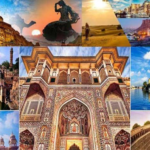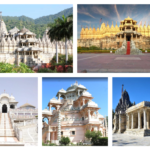Rajasthan, known as the land of kings and forts, embodies India’s rich architectural heritage through its majestic forts and ornate havelis. These structures, steeped in history and adorned with intricate designs, offer a glimpse into the opulent lifestyles and strategic brilliance of the region’s past rulers. Let’s delve into some of Rajasthan’s most remarkable architectural marvels:
Forts of Rajasthan
1. Amber Fort (Amer Fort), Jaipur
Perched majestically on a hilltop overlooking Maota Lake, Amber Fort is a stunning blend of Hindu and Mughal architectural styles. Constructed from red sandstone and marble, it boasts elaborate carvings, mirror work, and magnificent palaces like the Sheesh Mahal (Mirror Palace). The fort’s formidable walls and strategic positioning highlight its defensive prowess.
2. Jaigarh Fort, Jaipur
Adjacent to Amber Fort, Jaigarh Fort is renowned for housing the world’s largest wheeled cannon, Jaivana. This fort served as a military stronghold and includes palaces, granaries, and an armory museum. From its elevated position, it offers panoramic views of the Aravalli hills and Jaipur city.
3. Mehrangarh Fort, Jodhpur
Rising 400 feet above the city of Jodhpur, Mehrangarh Fort is an imposing structure with thick red sandstone walls. It features intricately latticed windows, expansive courtyards, and several palaces showcasing Rajput architecture. The fort also houses a museum displaying royal artifacts and weaponry.
4. Junagarh Fort, Bikaner
Built by Raja Rai Singh in the 16th century, Junagarh Fort exhibits a unique blend of Rajput and Mughal architectural styles. It boasts ornate palaces like Anup Mahal, Chandra Mahal, and Phool Mahal, adorned with intricate mirror work, frescoes, and gold leaf paintings.
5. Chittorgarh Fort, Chittorgarh
A UNESCO World Heritage site, Chittorgarh Fort is the largest fort in India, symbolizing Rajput valor and sacrifice. It encompasses impressive structures such as the Vijay Stambh (Tower of Victory), Kirti Stambh (Tower of Fame), and Rana Kumbha Palace, reflecting the grandeur of Rajputana architecture.
Havelis of Rajasthan
1. Patwon ki Haveli, Jaisalmer
A cluster of five havelis, Patwon ki Haveli is renowned for its intricate architecture and elaborate facades. Built in yellow sandstone by the wealthy Patwa merchant family, these havelis feature detailed carvings, jharokhas (overhanging balconies), and ornamental gateways.
2. Nathmal ki Haveli, Jaisalmer
Built by two brothers, Hathi and Lulu, Nathmal ki Haveli is a masterpiece of Rajputana architecture. Each brother oversaw the construction of one side of the haveli, resulting in a symmetrical yet distinct design. The haveli is adorned with intricate carvings depicting mythological themes and motifs.
3. Salim Singh ki Haveli, Jaisalmer
Constructed in the 18th century by Salim Singh, the prime minister of Jaisalmer, this haveli is known for its distinctive peacock-shaped roof and intricate stone carvings. Its balconies and windows are adorned with delicate craftsmanship, reflecting the opulence of its time.
4. Mandawa Havelis, Shekhawati Region
The Shekhawati region is famed for its beautifully painted havelis adorned with frescoes depicting mythological scenes, royal processions, and daily life. Mandawa town boasts numerous havelis like Gulab Rai Ladia Haveli, Murmuria Haveli, and Goenka Double Haveli, showcasing exquisite artwork.
Architectural Significance
Rajasthan’s forts and havelis are not just architectural wonders but also repositories of history, culture, and artistic traditions. They reflect the skill of Rajput and Mughal craftsmen, blending strategic military features with intricate decorative elements. These structures serve as reminders of Rajasthan’s royal heritage and continue to awe visitors with their majesty and historical significance.
Cultural Impact
The forts and havelis of Rajasthan have a profound cultural impact, symbolizing the valor of Rajput rulers, the cultural amalgamation with Mughal influences, and the artistic achievements of the region. They are integral to local festivals and events, providing a backdrop for cultural performances, folk music, and storytelling that celebrate Rajasthan’s rich cultural tapestry.
Conservation Efforts
Efforts are ongoing to preserve and restore Rajasthan’s forts and havelis, ensuring that future generations can continue to appreciate their architectural splendor and historical importance. Conservation projects, supported by governmental and non-governmental organizations, aim to maintain the structural integrity and authenticity of these heritage sites.
Conclusion
Rajasthan’s forts and havelis stand as enduring symbols of its royal past and architectural brilliance. From the formidable citadels that once guarded kingdoms to the ornate havelis that housed wealthy merchants, each structure tells a story of Rajasthan’s rich history and cultural heritage. Visiting these architectural wonders is not just a journey through time but an exploration of India’s vibrant past and enduring legacy.
Explore Rajasthan’s architectural marvels with Rajasthan Bhumi Tours



